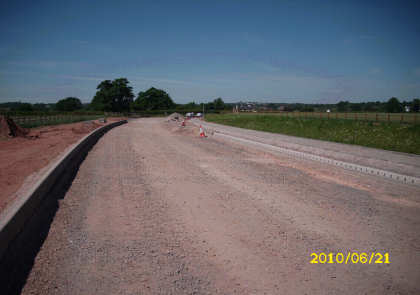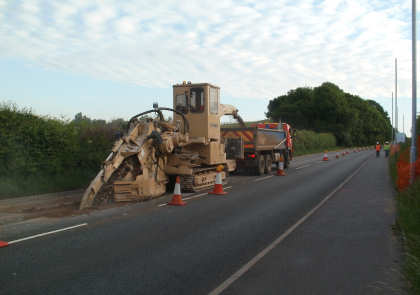Pipehill Junction Improvements |
80.2% |
Whole Project Award
Project Team:
Client: Staffordshire
City Council
Design: Staffordshire
City Council
Construction: Geoffrey
Osborne Limited
The Project
Pipehill Junction (the crossroads – between the A5190 Lichfield Road and the A461 Walsall Road) was earmarked as a priority site by Staffordshire County Council after 18 injury accidents were recorded over five years; two of them serious. This £1.8m safety upgrade entailed construction of a new 1 mile (approx) long road and a new roundabout.
In addition the works included:
- Replacing a four-way traffic light controlled junction with a three-way system.
- Construction of 9 balancing ponds.
- Landscaping, including trees and new hedges, and heather planted to complement nearby Pipehill Common.
- Decommissioning of the A5190.
- Diversion of overhead power cables, medium pressure gas main and BT fibre optic and copper cables.
The scheme will reduce traffic delays and improve air quality by reducing emissions from slow moving or stationary vehicles.
This scheme was highly rated with “performance beyond compliance” commendation by Considerate Constructors Scheme with several aspects recognised as “exceptional” and recorded zero accidents. Osborne turned a demanding muck shift contract into a sustainable cut and fill operation, making projected financial losses into a healthy profit whilst ensuring liaison and effective communications with all stakeholders. This demonstrates a scheme that everyone can be proud to be associated with.
All parties involved with the scheme worked closely to achieve successful completion of the project and to achieve a CEEQUAL Excellent Whole Project Award.
Challenges/ Successes
1. Boosting of green credentials and financial benefit
An early initiative to turn the muckaway operation into a
muckshift operation was progressed. This saved over 2,000
wagon movements with the associated pollution and removed
the requirement to install traffic management on an already
busy network for a period of 10 weeks. Osborne orchestrated
dialogue between local land agents, the Planning Department
and the Environment Agency (EA) to utilise available adjacent
land for deposit of excess material. This gave considerable
environmental benefits as well as improving the land.
2. Demanding cut and fill operation – innovative
technology applied
An interesting feature of the project was the pioneering solution
for the required cut and fill operation. The on-site engineering
team did not have to erect a single profile to sculpture the
banks, batters, ponds and formation levels of the road. Instead,
a 3D electronic model was created from data supplied by Staffordshire’s
Highways design office by the earthworks subcontractor. This
was converted into a software format used by the machine control
systems installed on the Caterpillar dozers. The Trimble GCS900
is a full 3D control system that puts the site plan - design
surfaces, grades and alignments - inside the cab. The on-board
computer uses this position information, and compares it to
the design elevation to compute cut or fill to grade. The
cut/fill data is also used to drive the valves for automatic
blade control to obtain the tightest of tolerances.
 3.
Ground Stabilisation
3.
Ground Stabilisation
An example of increasing the green credentials during ECI
stage of the scheme was to introduce lime stabilisation into
existing sandstone to create a hard compacted surface instead
of the proposed traditional capping layer. Test results were
instant, allowing Type 1 to be constructed in layers with
immediate effect. This cost effective solution mitigated the
importation of non-renewable aggregates, normally delivered
by road, thus reducing the carbon footprint.
The use of Granular fly ash material (GFA) in lieu of road base and warm asphalt were also proposed given the environmental benefits, but the Client rejected this proposal on cost grounds.
4. Reduction in Statutory Authority diversion works
 The
project demonstrates that considerate practice actually saves
the contractor money. Examples of money (public money) having
been saved through carrying out less disruptive activities
are:
The
project demonstrates that considerate practice actually saves
the contractor money. Examples of money (public money) having
been saved through carrying out less disruptive activities
are:
- Osborne worked closely with BT to agree an innovative solution to cable routing. New road levels were raised avoiding the need for diversion works. This saved the need for 16 weeks disruption for the public through 24/7 traffic management and installing varioguard. By avoiding the necessity for a diversion the project team saved £150k.
- After realising a design clash between existing statutory utilities and new drainage, Osborne introduced the use of a Trencher at night under traffic lights to place drainage in the carriageway. This saved time and money through value engineering.
- Close co-operation with Eon ensured the neighbours were given 10 days notice of power outage / disconnections rather than the statutory 4 days. The number of properties affected was consequently restricted to 39 in lieu of “half of the city of Lichfield”.
Through compensation events we also undertook works to facilitate
the statutory diversions which gave better control of operations
to meet key dates.
5. Considering the needs of others – a key
feature
A key feature of this project has been the way in which the
needs of others have been carefully considered and placed
at the forefront of planning and executing the works.
The following lists some “gestures” costing little but making someone’s day:
- In order to avoid any damage to or loss of farmer’s crops, Osborne sought a weed killer, which would not damage rapeseed and also deferred installing rabbit netting until the crops had been harvested.
- The special needs of one of our neighbours, who required daily medical treatment, were taken into account whilst planning of the works; access was maintained at all times for an ambulance.
- Following a complaint regarding speeding in the site compound, Osborne demonstrated zero tolerance with regard to safety by giving a written final warning immediately to all operatives.
Although disruption to road users & neighbours was inevitable, the site took great steps to ensure that such disruption was kept to a minimum.
Osborne ensured everyone was kept informed through a variety of measures including:
- Regular Liaison with our two local Parish Councils updating them on the scheme
- Initiating the provision of traffic management details to the local radio stations and the Staffordshire web site detailing all forthcoming closures.
- Writing to neighbours informing them of the need for night work shifts in addition to the usual working hours (07:30 – 17:30).
Osborne advised the client to undertake a “pre-stage
RSA 3 audit” prior to completion, so that any recommendations
could be undertaken. This mitigated the need for preliminaries
post contract completion when RSA 3 audits are traditionally
undertaken. All the above Lean Engineering Innovations have
been fed into the Partnership Framework Board to enable all
to learn.
6. Environmental Constraints
The site was close to a Site of Special Scientific Interest
(SSSI) with a population of great crested newts, with a breeding
season between July and September. Ducting work was carried
out in June once the project team’s ecologist had conducted
a daily fingertip search to ensure that it was safe for work
to go ahead. Specific site methodologies were adhered to,
to ensure there was no danger to the newts. A CCTV survey
was employed to check the presence of newts prior to puling
cables through the ducting. In carrying out the works early
it mitigated any potential delay to the programme.
In addition, a badger sett located within the works was
required to be closed ahead of the works, work was carried
out around a large oak tree protected by a Tree Protection
Order and Japanese Knotweed was removed from the site.
7. Performance measurement – good results
The Considerate Constructors Scheme awarded the team 37.5
out of 40 for performance. This was the highest score within
Osborne for 2010/2011. Staffordshire County Council awarded
Osborne’s team 91% against Improving Client Experience
KPIs.

